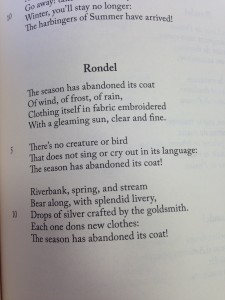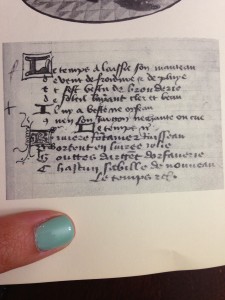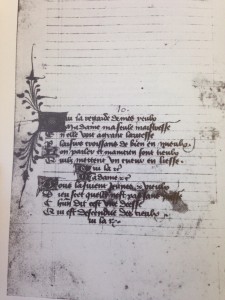About a week ago I wrote this post looking at Charles D’Orlean’s poem “Le temps a laissie son manteau,” and I was left with quite a few questions about the work, leading me to search out what is currently considered one of the most authoritative books on the subject (Poetry of Charles D’Orleans and His Circle by John Fox and Mary-Jo Arn) (and a great thank you to Jenni for taking the time to look at the Bodleian for me).
I immediately looked up the poem in the book, and found another translation than the one I previously posted by Stanley Appelbaum. This one is translated by R. Barton Palmer:
Both translations have their charm, and while neither is perfect I think they complement each other quite nicely.
However, the main question I had was a paleographic one. This the picture and original text from my blog last week:
I cannot tell for certain, but it appears two different hands worked on this text. The last five lines seem less careful than the first part, indicating that perhaps the first part was copied, while the latter writer was more confident and less concerned with making mistakes. Of course this is complete conjecture since the picture is not of the best quality, nor have I been able to find where it comes from, and it doesn’t help that the picture provided is not in color (the MS in question is written in predominantly red and redish brown ink). Also, it makes little sense as to why two people would split such a short poem. However, what I can say with more certainty is that this handwriting (top or bottom) of my picture is unlike MS 25458.
It turns out I was both right and wrong.
My first problem was with identifying the correct manuscript. Every source for the manuscript gave the correct number, but when running a search for MS 25458 on the Bibliotheque Nationale’s manuscript search, a different manuscript popped up, MS 19139. This is the MS I was referencing in the above passage – it has Charles D’Orleans works, and in the title MS 25458 is mentioned in parentheses. Very little exists on this MS except that it was an attempted replica of the original works D’Orleans, created by Garencieres and Chartier. However, the poems are not kept in the same order, some are missing, and it is constructed completely differently (hence my confusion of why none of the pictures I was finding of MS 25458 looked like the digitized one I found on the library website – however it has also been argued by Arn that the poems in MS 25458 are not in the order D’Orleans initially intended – a different argument altogether). Another thing that I found odd is that the imitation has been digitized, but not the original. In fact, two of D’Orlean’s most famous manuscripts cannot be found online, and only black and white copies exist of snippets of selected poems (the other being BL MS Harley 682).
Another small picture of MS 25458 I found in the Fox and Arn book looks very similar to my first sample:
However, there is a difference which I know is difficult to decipher providing how terrible the copies are, but the handwriting is definitely not the same, specifically throughout the first poem. In fact, the entirety of the manuscript is written in several hands in black ink with two main hands composing the majority of the work while the rest curiously interject throughout the verses only to add a few lines sparingly. This makes it quite possible that what I am seeing in the facsimile is accurate. Then, according to Patricia Stirnemann, the manuscript dates prior to the duke returning to France and was most likely written and commissioned while he was still in English custody, thus before 1440. If this is the case, then this also accounts for the disparity in handwriting. If the book of French verses was made in England, then the copyist may not have been completely familiar with the language, therefore prone to be much more careful with the copying. Nevertheless this does not address why the latter part of the poem is in a different, less careful (more cursive) style.
Another work I found about this manuscript was by J. Marie Guichard who presents all the poems and discusses who he believes was responsible for physically writing them into the manuscript – while the majority of the poems contain names underneath the titles, “Le temps” does not, meaning the writing could not be identified. And even though this does not tell us who wrote the poem, it implies that the writing belongs to someone who had not yet contributed to the manuscript, referring to the primary scribe and the duke. It has been noted by Arn and Fox that in all the texts Charles writes, he does so in a “very regular cursive Gothic book script,” which can be found at the end of the poem. However, the first part of the poem is closer to French Secretary. This would account for Guichard’s lack of name attribution to the poem, especially if he only allotted a cursory glance to the handwriting of each (which he can hardly be faulted for since he was not attempting to write a book on paleographic evidence of the manuscript, and again, the way the verses were split among writers does not make the most logical sense). My first assumption is that the poem was not finished at the time of copying and so space was left at the bottom (and I suppose this is an obvious enough conclusion revealing a pattern found often throughout manuscripts). Which brings me to my second assumption; as I mentioned earlier, I believe the bottom half of the poem was written by someone with more confidence in his writing, meaning that those last few lines were written in the same Gothic book script described by Arn and Fox, and that they were written in by the duke. He would not necessarily be copying his own work from a different source, or if he was, he would be familiar enough to where his hand would move with more freedom, unrestricted by the same fear of mistakes that a straight copyist might exhibit.
Lastly, there appears to be a disparity between what scholars believe to be the purpose of the manuscript. I have read that it was meant for personal use, and to be kept as a journal by Charles, but also that it was meant to be given as a gift. While this might seem trivial, the purpose for which the manuscript was made could potentially bolster an argument for how much time was to be spent on it, and with how much care it would be executed. Yet the fact that he had another commissioned to write the text demonstrates some meticulous precision on his part. In other words, even if he intended it for private use, he wanted to create a piece of art, and not simply rely on his own journal-like entries.
However, this is as much as I can possibly say without having seen any of the main manuscripts, and there currently doesn’t appear to be any published researched as to who copied each piece of the manuscript (and I say “published” because I am sure the research exists at least privately, especially considering the depth of detail Arn went into when annotating the Harley MS. I am almost certain she did similar with MS 25458 when writing the paleographic chapters in her most recent book – or at the very least is working on it some more now).
Also, should anyone be interested in the overarching themes within the poetry (quite a spectacular show), please refer to the Fox and Arn reference (below), as they have done a marvelous job of it.
Should anyone want to investigate any of this further, here is a list of the largest, or best known collections of Charles D’Orlean’s works (this is not an exhaustive list of all extant manuscripts containing his work):
Bibliotheque Nationale Fr. MS 25854 (not digitized)
Bibliotheque Nationale Fr. MS 19139 (digitized here)
Bibliotheque Nationale Fr. MS 1104 (not digitized)
Bibliotheque de l’Arsenal, MS 2017 (not digitized)
BL MS Harley 682 (not digitized)
BL MS Harley 6916 (not digitized)
BL MS Lansdowne 380 (not digitized)
BL MS Royal 16 F.ii (selected images here)
Bibliotheque de Grenoble MS 873 (not digitized)
Bibliotheque Inguimbertine, Carpentras MS 375 (not digitized)
Sources:
Arn, Mary-Jo. Charles d’Orleans and the Poems of BL Ms Harley 682.
Arn, Mary-Jo. Charles d’Orleans in England 1415-1440.
Arn, Mary-Jo and John Fox. Poetry of Charles D’Orleans and His Circle
Avril, Francois, and Patricia Stirnemann. Manuscrits elumine d’origin insulaire, VII-XXe siecle.
Gauchiard, J. Marie. Poesies de Charles d’Orleans.









My personal favourite translation is that by Oliver Bernard, featured among the Poems on the Underground:
–Rondel–
The weather’s cast its cloak of grey
Woven of wind and cold and rain,
And wears embroidered clothes again
Of clear sunshine, in fair array.
No beast, no bird, but in its way
Cries out or sings in wood and plain:
The weather’s cast its cloak of grey
Woven of wind and cold and rain.
River and spring and brook this day
Wear handsome liveries that feign
More silver stars than Charles’s Wain,
Mingled with drops of golden spray.
The weather’s cast its cloak of grey.
Such a beautiful translation. Thank you for sharing!